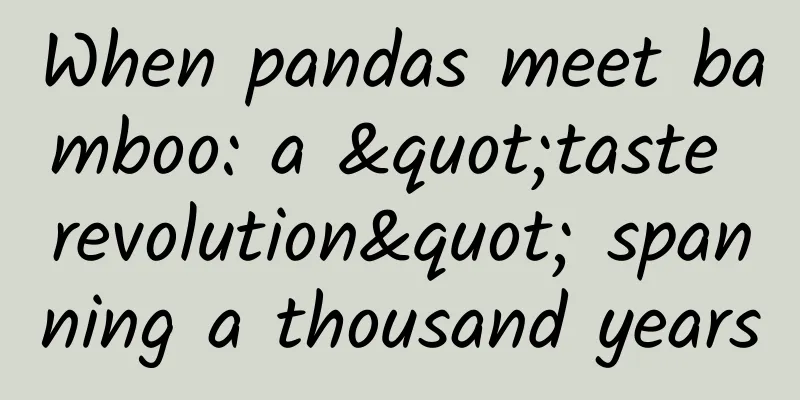When pandas meet bamboo: a "taste revolution" spanning a thousand years

|
The giant panda is China's national treasure. It is loved by people all over the world for its cute appearance. The mascots of the Beijing Summer Olympics, Jingjing, and the mascot of the Winter Olympics, Bingdundun, are both based on the giant panda. The cute and handsome Po in the cartoon "Kung Fu Panda" is also the childhood memory of many friends. The World Wildlife Fund also chose it as its logo. Over the past few decades, giant pandas have repeatedly gone abroad as friendly envoys, showing the world the black and white "face of China". It can be said that giant pandas have become one of the symbols of China. As a special kind of bear, giant pandas have many interesting characteristics. For example, they love to eat bamboo. The giant pandas we usually see in the zoo are either sleeping or chewing bamboo. This is not their fault, because bamboo is very poor in nutrition, and the digestive system of giant pandas is a relatively short carnivore configuration. They can only spend 16 hours a day to eat, so they have to live a life of "eating and sleeping, sleeping and eating". Giant panda eating bamboo Although modern giant pandas only hold bamboo and chew it every day, their ancestors were not picky eaters. The primitive pandas that lived in the Lufeng Basin of Yunnan Province in the Miocene about 7 million years ago already had a "sixth finger" similar to that of modern giant pandas for grasping bamboo, but their teeth were still closer to those of bears with a higher proportion of meat. This shows that the ancestors of giant pandas 7 million years ago were omnivores that loved to eat both meat and bamboo. As for why modern giant pandas have become professional "bamboo eaters", the current mainstream view is that about 2.4 to 2 million years ago, the ancestors of giant pandas lost the gene that could sense the freshness of meat, and from then on meat became tasteless, and then they completely entered the era of eating bamboo. However, in 2019, new research proposed a different view. The sixth finger of the giant panda's palm cannot actually be called a finger, it evolved from the wrist bone A reconstruction of the primitive panda. Their teeth are similar to those of bears that eat more meat. In 2019, in a joint study led by the Chinese Academy of Sciences, scientists used stable isotope analysis to study the eating habits of giant pandas. The so-called stable isotope analysis method is to judge the eating habits of animals by studying the stable isotopes (such as 13C and 15N) in the bones and teeth of organisms. After animals eat, the chemical symbols in the food will remain in their bodies. Different foods have different chemical symbols, so we can use this to determine what they ate before they died. Scientists compared the stable isotopes in the bones of giant pandas that lived in Yunnan 5,000 years ago and modern giant panda specimens. The results showed that the coefficient of variation of nitrogen stable isotope values in giant pandas 5,000 years ago was much higher than that of modern giant pandas , which is comparable to that of ordinary herbivorous animals. In addition, the stable isotope values of ancient giant panda bones collected from seven other places across the country are also significantly different from those of modern giant pandas, and all show a trend of greater coefficient of variation. It can be seen from this that 5,000 years ago, when Chinese civilization was just emerging, although giant pandas were already mainly vegetarians, they still did not only like to eat bamboo like the giant pandas today. Comparison of nitrogen and oxygen isotopes in giant pandas 5,000 years ago and today (red is the value of ancient giant pandas, green is the value of modern giant pandas) If this view is true, then the history of giant pandas as "cute bamboo-eating beasts" is only a short five thousand years. In other words, when the Three Sovereigns and Five Emperors were vying for supremacy in the Central Plains, giant pandas still had a voracious appetite for anything, but in the next five thousand years, they became professional bamboo eaters. At this point someone may ask: Five thousand years is still too short for the evolution of organisms. Changing eating habits in five thousand years is as "unbelievable" as some animal novels! In fact, the cause of all this may be human activities . 5,000 years ago, the majority of giant pandas were those who were not picky eaters, and the ancestors of bamboo eaters were on the edge of living in seclusion in the mountains. About 4,000-2,000 years ago, with the birth of the country and social changes, humans gradually gained the ability to reclaim forests. Especially during the Spring and Autumn Period and the Warring States Period, with the development of iron tools, agricultural production efficiency was greatly improved, and those members with more diverse diets would inevitably encroach on human farmland during this period. Naturally, they would be hunted as "pests" by humans. At the same time, for a series of purposes such as sacrifice, humans would also actively hunt wild giant pandas. These members with more diverse diets eventually died out under constant attack. Only the ancestors of today's bamboo eaters lived in the mountains, and their habit of eating bamboo made them less likely to have conflicts with humans over their diet, and they eventually survived to this day... Giant panda skeleton found in Han Dynasty tomb Comparison of giant panda distribution in ancient and modern times In the expansion of human civilization, it is not just the pandas that have been forced to "change their habits". During the same period, the crested ibis, one of the four treasures of the Qinling Mountains along with the giant panda, once fell to the brink of extinction, and the remaining individuals lost the ability to migrate and became resident birds. Because of the construction of the Columbia Dam, the sturgeon can no longer see the sea and can only stay in fresh water forever. Some animals, such as the dodo, the passenger pigeon, the thylacine, and the white sturgeon, have become eternal memories in the long river of history... Although the North Sea is far away, it can be reached by the rising tide. The morning has passed, but it is not too late to look forward to the evening. We have already lost a lot, so let's not lose more. Author: Qianxi Jun Editor: Dong Xiaoxian Reviewer: Zhang Chao, Li Peiyuan |
<<: Children's tic disorder: beware of the health risks hidden in "small movements"
>>: When the Great Cold comes, how should we eat the “best meat for winter tonic”?
Recommend
Xi'an half-service massage release
Xi'an Tea Tasting has its own studio: Senior ...
Why is "Airbus" a Chinese scam that fooled many media outlets?
If I tell you that a technological invention that...
How to write a competitive product analysis, I have summarized 5 common problems and 1 set of methodology!
There is no doubt that competitive product analys...
Reviewing TikTok: How to achieve user growth?
There are many articles about how TikTok reached ...
How do operations personnel start to increase user scale to ensure product revenue?
First, a common question: What is the most import...
If you want to play, play the most advanced one! The ultimate cost-effective tool is here!
Since the CES (Consumer Electronics Show) at the ...
"Red Coast Base" is more than just science fiction: We are looking for alien civilizations in the radio waves
The "real and imaginary" Red Coast Base...
Mysterious "architecture" on the African continent - the strange African ant nest
Strange African ant nest When I was working in Af...
Case analysis of private domain growth of new tea drinks!
The tea beverage industry market has continued to...
Is the existence of typhoons a good thing or a bad thing for humans? Where do typhoons come from? Where do they go in the end?
29% of the earth's surface is land, and 71% i...
The "Moe Overlord" has been discovered
Ancient discovery: 450 million years ago, this an...
He gained 330,000 followers in one event, and used these 3 secrets to make his circle of friends explode!
As we all know, online activities, especially onl...
How do we survive the winter when the temperature is -53℃? Mohe residents: We wear short sleeves in the house!
Mohe, Heilongjiang Extremely cold weather continu...
How does Xiaohongshu operate a UGC content sharing community?
Background : Today, Xiaohongshu ’s slogan has bee...









